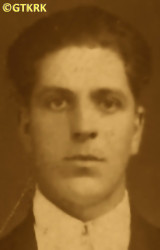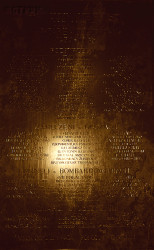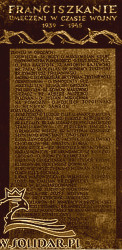Roman Catholic
St Sigismund parish
05-507 Słomczyn
85 Wiślana Str.
Konstancin deanery
Warsaw archdiocese, Poland
full list:
displayClick to display full list

searchClick to search full list by categories
wyświetlKliknij by wyświetlić pełną listę po polsku

szukajKliknij by przeszukać listę wg kategorii po polsku

Martyrology of the clergy — Poland
XX century (1914 – 1989)
personal data
surname
WIŚNIOWSKI
forename(s)
Michael (pl. Michał)
religious forename(s)
Mirocles Mary (pl. Mirokles Maria)
function
laybrother
creed
Latin (Roman Catholic) Church RCmore on
en.wikipedia.org
[access: 2014.09.21]
congregation
Order of Friars Minor Conventual OFMConvmore on
en.wikipedia.org
[access: 2013.05.19]
(i.e. Conventual Franciscans)
diocese / province
Immaculate Mary province OFMConvmore on
pl.wikipedia.org
[access: 2014.08.18]
st Anthony of Padua and bl. James Strzemię province OFMConvmore on
pl.wikipedia.org
[access: 2014.08.18]
date and place
of death
28.06.1941

Rava‐Ruskatoday: Rava‐Ruska urban hrom., Lviv rai., Lviv obl., Ukraine
more on
en.wikipedia.org
[access: 2022.01.16]
details of death
After German invasion of Poland on 01.09.1939 (Russians invaded Poland 17 days later) and start of the World War II released on 06.09.1939 from Niepokalanów monastery.
Moved east to his family.
Prob. visited often — during the Russian occupation — a Franciscan convent in Rava–Ruska, c. 6 km from Potylich.
There during Germans attack on 22.06.1941 of their erstwhile ally, Russians, four Franciscan friars were murdered on 25.06.1941 by the Russians.
Three days later Germans entered the town.
On the same day he perished in unclear circumstances — according to some sources shot by escaping Russians, then cut by sabers and finally tied to a horse and dragged through the town streets.
alt. details of death
According to other sources murdered by the advancing Germans.
cause of death
mass murder
perpetrators
Germans / Russians
sites and events
06.1941 massacres (NKVD)Click to display the description, Ribbentrop‐MolotovClick to display the description, Pius XI's encyclicalsClick to display the description
date and place
of birth
10.07.1910

Potelychtoday: Rava‐Ruska urban hrom., Lviv rai., Lviv obl., Ukraine
more on
uk.wikipedia.org
[access: 2022.08.08]
religious vows
02.08.1939 (temporary)
positions held
1937 – 1939
friar — Niepokalanówtoday: part of Paprotnia village, Teresin gm., Sochaczew pov., Masovia voiv., Poland
more on
en.wikipedia.org
[access: 2021.10.09] ⋄ Immaculate Conception of the Blessed Virgin Mary monastery, Conventual Franciscans OFMConv — administration department (1939), monthlies' dispatch department (1938‐1939), „Little Daily” dispatch department (1938), monastery gatekeeper (1938), food department in the dairy (1937‐1938)
01.08.1938 – 02.08.1939
novitiate — Niepokalanówtoday: part of Paprotnia village, Teresin gm., Sochaczew pov., Masovia voiv., Poland
more on
en.wikipedia.org
[access: 2021.10.09] ⋄ Immaculate Conception of the Blessed Virgin Mary monastery, Conventual Franciscans OFMConv
08.04.1937
accession — Conventual Franciscans OFMConv
others related
in death
GAWĘDZKIClick to display biography Andrew (Bro. Michael Mary), NOSIDLAKClick to display biography Florian (Bro. Didacus), SCHNERCHClick to display biography Edward Casimir (Bro. Peregrine), SMOLEŃClick to display biography Thaddeus (Bro. Ferdinand)
sites and events
descriptions
06.1941 massacres (NKVD): After German attack of Russian‐occupied Polish territory and following that of Russia itself, before a panic escape, Russians murdered — in accordance with the genocidal order issued on 24.06.1941 by the Russian interior minister Lawrence Beria to murder all prisoners (formally „sentenced” for „counter‐revolutionary activities”, „anti‐Russian acts”, sabotage and diversion, and political prisoners „in custody”), held in NKVD‐run prisons in Russian occupied Poland, Lithuania, Latvia and Estonia — c. 40,000‐50,000 prisoners. In addition Russians murdered many thousands of victims arrested after German attack regarding them as „enemies of people” — those victims were not even entered into prisons’ registers. Most of them were murdered in massacres in the prisons themselves, the others during so‐called „death marches” when the prisoners were driven out east. After Russians departure and start of German occupation a number of spontaneous pogroms of Jews took place. Many Jews collaborated with Russians and were regarded as co‐responsible for prison massacres. (more on: en.wikipedia.orgClick to attempt to display webpage
[access: 2021.12.19])
Ribbentrop‐Molotov: Genocidal Russian‐German alliance pact between Russian leader Joseph Stalin and German leader Adolf Hitler signed on 23.08.1939 in Moscow by respective foreign ministers, Mr. Vyacheslav Molotov for Russia and Joachim von Ribbentrop for Germany. The pact sanctioned and was the direct cause of joint Russian and German invasion of Poland and the outbreak of the World War II in 09.1939. In a political sense, the pact was an attempt to restore the status quo ante before 1914, with one exception, namely the „commercial” exchange of the so‐called „Kingdom of Poland”, which in 1914 was part of the Russian Empire, fore Eastern Galicia (today's western Ukraine), in 1914 belonging to the Austro‐Hungarian Empire. Galicia, including Lviv, was to be taken over by the Russians, the „Kingdom of Poland” — under the name of the General Governorate — Germany. The resultant „war was one of the greatest calamities and dramas of humanity in history, for two atheistic and anti‐Christian ideologies — national and international socialism — rejected God and His fifth Decalogue commandment: Thou shall not kill!” (Abp Stanislav Gądecki, 01.09.2019). The decisions taken — backed up by the betrayal of the formal allies of Poland, France and Germany, which on 12.09.1939, at a joint conference in Abbeville, decided not to provide aid to attacked Poland and not to take military action against Germany (a clear breach of treaty obligations with Poland) — were on 28.09.1939 slightly altered and made more precise when a treaty on „German‐Russian boundaries and friendship” was agreed by the same murderous signatories. One of its findings was establishment of spheres of influence in Central and Eastern Europe and in consequence IV partition of Poland. In one of its secret annexes agreed, that: „the Signatories will not tolerate on its respective territories any Polish propaganda that affects the territory of the other Side. On their respective territories they will suppress all such propaganda and inform each other of the measures taken to accomplish it”. The agreements resulted in a series of meeting between two genocidal organization representing both sides — German Gestapo and Russian NKVD when coordination of efforts to exterminate Polish intelligentsia and Polish leading classes (in Germany called «Intelligenzaktion», in Russia took the form of Katyń massacres) where discussed. Resulted in deaths of hundreds of thousands of Polish intelligentsia, including thousands of priests presented here, and tens of millions of ordinary people,. The results of this Russian‐German pact lasted till 1989 and are still in evidence even today. (more on: en.wikipedia.orgClick to attempt to display webpage
[access: 2015.09.30])
Pius XI's encyclicals: Facing the creation of two totalitarian systems in Europe, which seemed to compete with each other, though there were more similarities than contradictions between them, Pope Pius XI issued in 03.1937 (within 5 days) two encyclicals. In the „Mit brennender Sorge” (Eng. „With Burning Concern”) published on 14.03.1938, condemned the national socialism prevailing in Germany. The Pope wrote: „Whoever, following the old Germanic‐pre‐Christian beliefs, puts various impersonal fate in the place of a personal God, denies the wisdom of God and Providence […], whoever exalts earthly values: race or nation, or state, or state system, representatives of state power or other fundamental values of human society, […] and makes them the highest standard of all values, including religious ones, and idolizes them, this one […] is far from true faith in God and from a worldview corresponding to such faith”. On 19.03.1937, published „Divini Redemptoris” (Eng. „Divine Redeemer”), in which criticized Russian communism, dialectical materialism and the class struggle theory. The Pope wrote: „Communism deprives man of freedom, and therefore the spiritual basis of all life norms. It deprives the human person of all his dignity and any moral support with which he could resist the onslaught of blind passions […] This is the new gospel that Bolshevik and godless communism preaches as a message of salvation and redemption of humanity”… Pius XI demanded that the established human law be subjected to the natural law of God , recommended the implementation of the ideal of a Christian state and society, and called on Catholics to resist. Two years later, National Socialist Germany and Communist Russia came together and started World War II. (more on: www.vatican.vaClick to attempt to display webpage
[access: 2023.05.28], www.vatican.vaClick to attempt to display webpage
[access: 2023.05.28])
sources
personal:
www.bj.uj.edu.plClick to attempt to display webpage
[access: 2012.11.23], www.ksiegazmarlych.franciszkanie.plClick to attempt to display webpage
[access: 2013.01.13], www.teresin.plClick to attempt to display webpage
[access: 2015.04.18]
bibliographical:
„Biographical–bibliographical dictionary of Polish Conventual Franciscan Fathers murdered and tragically dead in 1939‐1945”, Lukas Janecki, Franciscan Fathers’ Publishing House, Niepokalanów, 2016
„A martyrology of Polish clergy under German occupation, 1939‐1945”, Fr Szołdrski Vladislaus CSSR, Rome 1965
original images:
www.sowiniec.com.plClick to attempt to display webpage
[access: 2014.07.11]
LETTER to CUSTODIAN/ADMINISTRATOR
If you have an Email client on your communicator/computer — such as Mozilla Thunderbird, Windows Mail or Microsoft Outlook, described at WikipediaPatrz:
en.wikipedia.org, among others — try the link below, please:
LETTER to CUSTODIAN/ADMINISTRATORClick and try to call your own Email client
If however you do not run such a client or the above link is not active please send an email to the Custodian/Administrator using your account — in your customary email/correspondence engine — at the following address:

giving the following as the subject:
MARTYROLOGY: WIŚNIOWSKI Michael
To return to the biography press below:
 Click to return to biography
Click to return to biography











